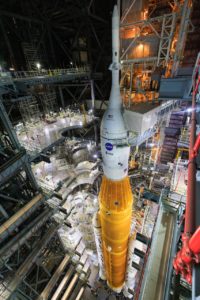Dell Technologies Helps Power NASA’s Artemis I to the Moon
ROUND ROCK, Texas, Nov.16, 2022 -- Today, NASA successfully launched Artemis I, completing the first step to put humans back on the moon since the Apollo 17 mission in 1972. Dell Technologies’ innovation provided the compute muscle to make this happen. Dell is the company that has helped millions of businesses enter the modern technological era – so it only makes sense that Dell would be there when NASA needed that same transformation.
Key Facts About This Launch:
- When launching Apollo 17 in the 70s, NASA’s server-equipped firing room had the compute power of a present-day smart phone. In collaboration with Dell, NASA updated this room with Dell PowerEdge servers. Just one modern server increases compute power 1,800% compared to the last mission to the moon.
- These servers enable NASA to run flight software applications, perform system monitoring capabilities, analyze data in real-time, and more.
- Dell Precision workstations act as a viewing portal into the complex datasets, allowing NASA to interpret the over 185,000 constantly evolving critical data points.
- NASA had Dell support onsite in the lead-up to launch and on launch day to ensure teams could meet their requirements for a safe and successful launch.
The following section of this article is a blog post by Dell’s Rajesh Pohani, vice president of Portfolio and Product Management, PowerEdge, HPC and Core Compute, which goes into more detail.
We talk with customers every day, who are changing the world, and I am constantly inspired by their work, passion and drive. But there’s nothing quite like talking with those in the space industry. So when NASA announced Artemis I, the curiosity of my 12-year-old self was reignited with the thrill of exploring deep space in ways previously thought impossible and with the possibility of bringing humans to the moon again for the first time since the Apollo 17 mission in 1972.

Artemis I and the Orion spacecraft in NASA’s Vehicle Assembly Building (VAB) at Kennedy Space Center, Florida on Tuesday, Aug. 16, 2022. Credit: NASA/Frank Michaux.
On behalf of Dell, I’d like to congratulate NASA on today’s successful launch of the Artemis I flight test. Dell has provided computing systems and services to NASA for more than a decade, working towards a shared goal of human progress. This uncrewed flight is the first in a series of increasingly complex missions that will enable human exploration to the moon and Mars. The 322 ft., 5.75-million-pound rocket will launch Orion into orbit, NASA’s next-generation spacecraft designed to carry astronauts to destinations in deep space.
A half century ago, NASA launch control architects used huge computer systems taking up entire rooms that had roughly the computing power of something in your pocket—a present-day smart phone. To put this into perspective, just one Dell PowerEdge server is roughly 20 times faster, packing 16,000 times the amount of RAM, and increases compute power by nearly 1,800% compared to the entire firing room system used in the 1970s, or one smart phone today. Imagine what an entire room of PowerEdge servers can do now.
Today, with Artemis I, and eventually Artemis II and Artemis III, NASA launch control architects, engineers and technicians are using substantially more compact Dell PowerEdge servers in the same storied rooms used in the Apollo missions to deliver the compute muscle and resiliency needed for enormously complex tasks. These servers enable NASA to run flight software applications, perform system monitoring capabilities and analyze data in real-time. With Dell Precision workstations, flight surgeons, orbital test directors, meteorologists and other specialists have consoles to interpret the 185,000 critical data points and telemetry coming from monitoring the launch at every manageable level. This gives countless insights and greater control over launches that was unfathomable on our last manned flight to the moon.
Throughout the launch and mission, Dell products are digesting millions of data points and allowing those in control to interface with both the servers at Launch Control and the rocket en route.
In addition to providing part of the computer system within the Launch Control System, NASA teams use Dell support to assist in troubleshooting potential issues and ensuring teams can meet their requirements for launch. Dell field engineers also are onsite to provide immediate support and services as needed to ensure reliable IT and safe and secure computer systems during the countdown sequence.
We often think about how technology impacts our daily lives at home and at work. In this case, highly sophisticated systems like those at NASA’s Kennedy Space Center in Florida are evolving alongside the rest of the world, helped in part by Dell innovation, to facilitate space exploration.
Following the successful launch and completion of the uncrewed Artemis I flight test, Artemis II will take a crew of astronauts on a slightly different trajectory in 2024, launching them into lunar orbit while testing Orion’s critical systems with humans onboard. Eventually, Artemis III will send astronauts, including the first woman and person of color to the moon.
Though options are endless for where to explore next in the vast universe, humans have set their sights on taking their first steps on Mars with knowledge gleaned from Artemis missions and this historic return to our moon. Dell will continue to support NASA to ensure space exploration and human progress flourishes.
Exploration continues to be an enduring part of the human spirit, and the 12-year-old in me can’t wait for what comes next. Congratulations, again, to all the teams involved in today’s historic launch.
Source: Dell Technologies










